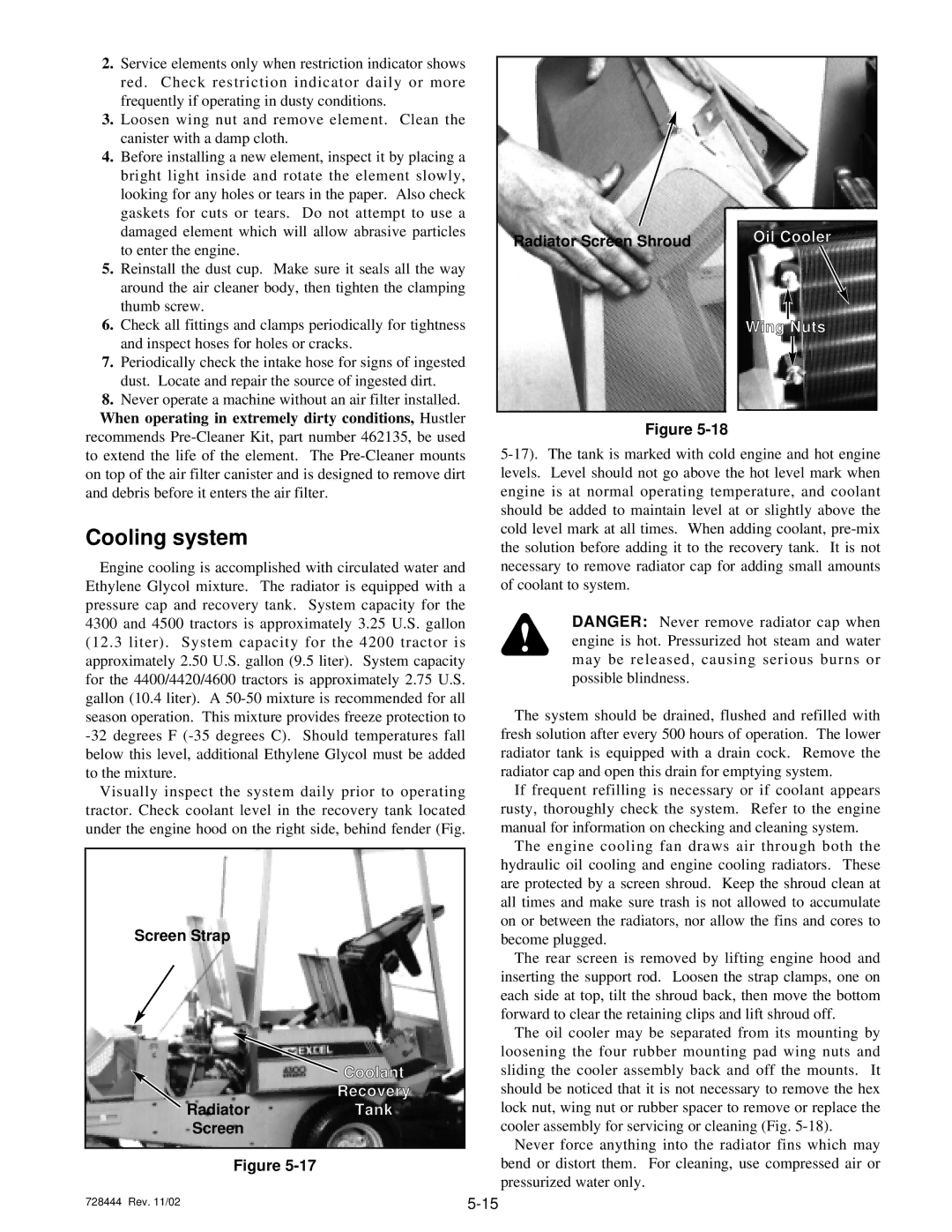
2.Service elements only when restriction indicator shows red. Check restriction indicator daily or more frequently if operating in dusty conditions.
3.Loosen wing nut and remove element. Clean the canister with a damp cloth.
4.Before installing a new element, inspect it by placing a bright light inside and rotate the element slowly, looking for any holes or tears in the paper. Also check gaskets for cuts or tears. Do not attempt to use a damaged element which will allow abrasive particles to enter the engine.
5.Reinstall the dust cup. Make sure it seals all the way around the air cleaner body, then tighten the clamping thumb screw.
6.Check all fittings and clamps periodically for tightness and inspect hoses for holes or cracks.
7.Periodically check the intake hose for signs of ingested dust. Locate and repair the source of ingested dirt.
8.Never operate a machine without an air filter installed. When operating in extremely dirty conditions, Hustler
recommends
Cooling system
Engine cooling is accomplished with circulated water and Ethylene Glycol mixture. The radiator is equipped with a pressure cap and recovery tank. System capacity for the 4300 and 4500 tractors is approximately 3.25 U.S. gallon (12.3 liter). System capacity for the 4200 tractor is approximately 2.50 U.S. gallon (9.5 liter). System capacity for the 4400/4420/4600 tractors is approximately 2.75 U.S. gallon (10.4 liter). A
Visually inspect the system daily prior to operating tractor. Check coolant level in the recovery tank located under the engine hood on the right side, behind fender (Fig.
Screen Strap
Coolant
Recovery
RadiatorTank
Screen
Figure
728444 Rev. 11/02
Radiator Screen Shroud | Oil Cooler |
| Wing Nuts |
Figure |
|
DANGER: Never remove radiator cap when engine is hot. Pressurized hot steam and water may be released, causing serious burns or possible blindness.
The system should be drained, flushed and refilled with fresh solution after every 500 hours of operation. The lower radiator tank is equipped with a drain cock. Remove the radiator cap and open this drain for emptying system.
If frequent refilling is necessary or if coolant appears rusty, thoroughly check the system. Refer to the engine manual for information on checking and cleaning system.
The engine cooling fan draws air through both the hydraulic oil cooling and engine cooling radiators. These are protected by a screen shroud. Keep the shroud clean at all times and make sure trash is not allowed to accumulate on or between the radiators, nor allow the fins and cores to become plugged.
The rear screen is removed by lifting engine hood and inserting the support rod. Loosen the strap clamps, one on each side at top, tilt the shroud back, then move the bottom forward to clear the retaining clips and lift shroud off.
The oil cooler may be separated from its mounting by loosening the four rubber mounting pad wing nuts and sliding the cooler assembly back and off the mounts. It should be noticed that it is not necessary to remove the hex lock nut, wing nut or rubber spacer to remove or replace the cooler assembly for servicing or cleaning (Fig.
Never force anything into the radiator fins which may bend or distort them. For cleaning, use compressed air or pressurized water only.
